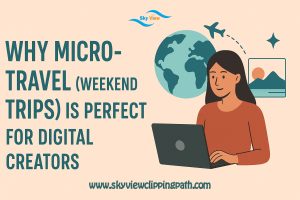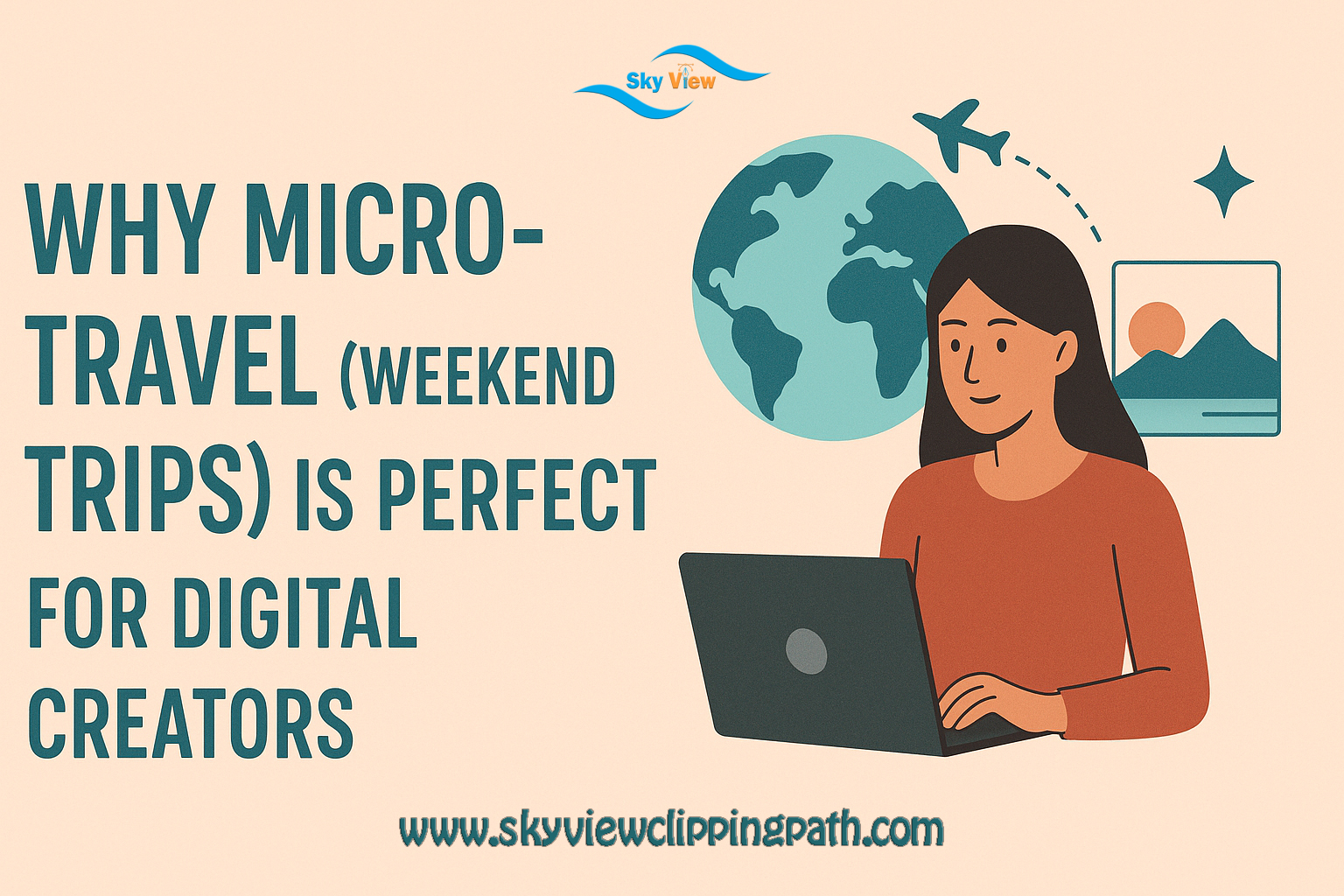Introduction
Digital creators — bloggers, podcasters, videographers, social media managers, designers, and freelance writers — live at the intersection of creativity and routine. While consistent output is valuable, creativity often needs fresh fuel, short weekend trips designed to maximize inspiration, rest, and content production in 48–72 hours. Unlike long vacations (which are amazing but rare), micro-travel is repeatable, low-cost, and strategically aligned with a creator’s workflow. In this post, we’ll unpack why micro-travel is perfect for digital creators and how to structure weekend trips so they power both wellbeing and output.
1. Immediate creative refresh without major downtime
Creators frequently face creative blocks. A change of environment — even a quick one — interrupts stale thought patterns. The brain notices new stimuli: architecture, smells, light, and people. These small sensory changes trigger associative thinking, a key ingredient for idea generation. A well-planned micro-trip can provide that jolt of novelty while leaving your content calendar intact.
Practical tip: Schedule a 48-hour trip around low-output calendar windows. Bring a single “idea capture” notebook or voice memo app and commit to capturing at least 10 new content ideas while you’re away.
2. Better content opportunities (authentic locations + micro-stories)
Creators need content that feels real and lived-in. Micro-travel provides dozens of “micro-stories” — short sequences you can spin into posts, Reels, threads, or postcards for email subscribers. A sunrise hike, a street food vendor, or a quirky local shop can each become a standalone post or a recurring series (“Weekender Finds”).
Practical tip: Make a micro-content checklist: 1 hero photo, 5 short-form videos (5–20s), 3 B-roll shots, and one long-form idea (blog, mini-podcast, or tutorial). Aim for repurposing: one video + one photo = 3–5 social posts.
3. Productivity with boundaries — work and rest
Micro-travel forces a condensed approach to work. With limited time, creators prioritize high-impact tasks: batching, editing, and scheduling. This pressure can actually increase productivity because decisions are simplified: what must be done now vs what can wait. Also, being away from the usual desk removes micro-distractions (laundry, house chores, neighborhood noise).
Practical tip: Time-block your weekend: morning creative sprint (2–3 hours), mid-day explore + capture, late afternoon edit/polish (1–2 hours), evening rest/network. Use offline modes for creative work if connectivity is variable.
4. Cost-effective, frequent renewals of inspiration
Big trips are expensive and infrequent. Micro-travel scales: you can take multiple weekend getaways throughout the year. This frequency compounds creative benefits — regular resets prevent burnout and maintain momentum.
Practical tip: Use local transport hacks: early-bird train tickets, carpooling, or regional buses. Night or off-season stays can be much cheaper and less crowded.
5. Authentic community and networking
Small towns, local co-working cafés, and weekend markets are full of human stories. Micro-travel opens avenues to collaborate with other creators, feature local makers, or interview interesting people for podcasts and newsletters. These human touches enrich content more than staged shoots ever can.
Practical tip: Before you go, check local community boards or social groups for events, markets, or meetups. Offer to trade services (e.g., a headshot session in exchange for a coffee) to build goodwill and content.
6. Easier experimentation with formats and niches
Micro-trips are low-risk laboratories. Want to test a new video format, podcast episode structure, or photo editing style? Try it on a weekend escape. Short cycles let you experiment and get quick feedback from your audience.
Practical tip: Announce the experiment to followers (“I’m testing a 60-second narrative mini-vlog this weekend — feedback welcome!”). Transparency builds engagement and gives you directional feedback.
7. Mental health and sustainable creativity
The creative life is emotionally intense. Regular short breaks support mental health without taking you offline for too long. Micro-travel promotes sleep quality, exposure to nature, and reduced screen time — all of which improve long-term creative output.
Practical tip: Plan one non-screen block daily (e.g., 90 minutes) to walk, cook, or journal. Treat this as part of the creative process rather than a guilty pause.
8. Practical gear list for creators on a micro-trip
- Lightweight laptop or tablet + charger
- Compact camera or smartphone with stabilization
- Portable SSD or SD cards + small card reader
- Noise-cancelling earphones
- Portable battery pack
- Minimal lighting (clip-on LED or small ring light, optional)
- Notebook & pen
- Flexible tripod or gorillapod
Tip: Pack with repurposing in mind — gear that helps both creation and comfort (e.g., a camera that doubles as a document scanner).
9. How to plan a weekend micro-trip for maximum output (a step-by-step)
- Pick a theme. (e.g., “Riverside Food Tour” or “Historic Architecture Walk”)
- Scout briefly. Use maps and local blogs the night before to mark 5-7 capture spots.
- Batch the tasks. Morning capture, afternoon edit, evening schedule/publish.
- Automate where possible. Queue social posts before you leave for minimal distraction.
- Leave buffer time. One pocket of unplanned time invites serendipity — often the best content arises then.
10. Repurposing micro-trip content for maximum ROI
A 48-hour trip can produce content that fuels 2–6 weeks:
- Instagram Reel → short clip + carousel → blog expanded version.
- B-roll → background for podcast videos or YouTube shorts.
- Interviews → 1 podcast episode + 3 quote posts + newsletter excerpt.
Tip: Create a “repurpose map” before you go: one recorded interview = 1 podcast, 3 audiograms, 5 quote cards, and a blog highlight.
FAQs
Q1: Aren’t weekend trips disruptive to my publishing schedule?
A: Not if you plan. Micro-travel encourages batching — prepare evergreen posts or schedule content before you leave. Use the trip to capture fresh content that you can edit and schedule during short time blocks.
Q2: How do I balance work and relaxation on a trip?
A: Time-block. Decide what’s non-negotiable (e.g., two 90-minute creative sprints) and which hours are reserved for rest. Treat rest as productive — it replenishes creative energy.
Q3: What if I have a

A: Make micro-travel local. Explore nearby towns, camping sites, or staycations. Use public transport and low-cost stays like guesthouses or compact Airbnbs.
Q4: How can I capture high-quality audio and video without heavy gear?
A: Modern smartphones are excellent. Use a compact lavalier mic or a small shotgun mic, and prioritize good lighting and steady framing. A small tripod and a portable LED go a long way.
Q5: Can micro-travel help grow my audience?
A: Yes. Authentic local content and repeatable weekend series are shareable and relatable. Consistent micro-stories build familiarity and can attract niche audiences.
Conclusion
Micro-travel aligns perfectly with the modern digital creator’s need for consistent output, fresh ideas, and sustainable well-being. Short weekend trips deliver novelty, authentic content, productive constraints, and low-cost experimentation — all without long absences from your audience. With simple planning and a minimalist gear kit, a 48–72-hour micro-trip can rejuvenate your creative reservoir and produce a month’s worth of repurposable content. Make micro-travel part of your creative rhythm: travel small, create big.
www.skyviewclippingpath.com
